Lecture
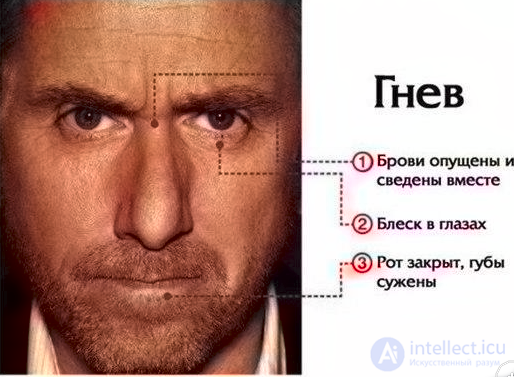
Anger, or anger, is perhaps the most dangerous emotion. When you experience anger, you are most likely intentionally harming other people. If someone is angry with you and you know his reasons, then the aggressive behavior of this person will become clear to you, even if you condemn him for his inability to control his emotions. On the contrary, a person carrying out unprovoked attacks on other people and not experiencing anger at the same time will seem strange or even abnormal to you. Part of the experience of experiencing anger is the risk of losing control. When a person says that he was angry, this, apparently, can explain his regrets about his deed: “I know that I shouldn’t have said that to him (to bite him), but I was beside myself - I just lost my head!” specifically explain that when they are angry, they should not cause physical harm to anyone. Children can also be taught to control any visible manifestations of anger. Boys and girls are usually told different things about anger: girls are taught to restrain their anger, and boys are encouraged to exercise it in relation to those peers who provoke them to it. Adults are often characterized by the way they cope with their anger: “discreet”, “hot”, “explosive”, “hot-tempered”, “cold-blooded”, etc.
Anger can occur for a variety of reasons. The first reason is frustration (nervous exhaustion) caused by numerous obstacles and hindrances and hindering progress towards the goal. Frustration can bear on itself a specific imprint of the task that you solve, or be of a more general nature, determined by your lifestyle. Your anger will arise with greater probability and will be more powerful if you consider that the person who caused the interference to you acted despotically, unfairly, or just to spite you. If a person intentionally wants to cause frustration in you or brings you to complete nervous exhaustion simply because you cannot understand how his actions can affect your activity, then you are more likely to feel anger than when you think that he simply has no choice. But the obstacle causing frustration is not necessarily some kind of person. You may be angry with an object or a natural phenomenon that caused your frustration, although you may feel that your anger is less justified.
Most likely, your actions in a state of anger caused by frustration will be aimed at removing the obstacle through a physical or verbal attack. Of course, frustration may be stronger than you, and then your protest efforts will be meaningless. However, anger can still persist, and at the same time you will direct it to a person - you can curse him, beat him, etc. Or you can show your anger by cursing and cursing this person when he is too far away from you. to punish you for such behavior. You can express your anger symbolically, attacking what a person you associate with, or directing anger to a safer or more convenient target - the so-called scapegoat.
The second cause of anger is physical threat. If a person who threatens you physically is weak and unable to harm you, then you are more likely to experience contempt than anger. If a person who threatens you physically is clearly stronger than you, then you are likely to experience fear rather than anger. Even if your strengths are about equal, you can experience anger and fear at the same time. Your actions in conditions where your anger is caused by the threat of physical harm to you, can be an attack on the enemy, a verbal warning or intimidation or simply flight. Even in the case of escape, when you seem to be afraid, you can continue to feel anger.
The third cause of anger can be someone’s actions or statements that make you feel that you are being morally and not physically damaged. An insult, a denial, or any act that disrespects your feelings can make you angry. At the same time, the more mentally attached you are to a person who causes you moral damage, the more you experience pain and anger from his actions. Insulting someone who causes you little respect, or refusal from a person whom you have never considered your friend or lover, may in extreme cases cause scorn or surprise. On the contrary, if the offense is caused to you by a person you have cared about a lot, then you may feel sadness or sadness at the same time as anger. In some situations, you may love so much a person who causes you suffering, or be unable to be angry with him (or any person at all), that you start looking for rational reasons for his painful actions for you to do your own actions, and then feel anger instead of anger the guilt. In other words, you feel anger towards yourself, not towards the person who caused you heartache. And again, as in the case of frustration, if the person who makes you suffer deliberately does this, you are more likely to feel angry than if he acted unintentionally or in a state of loss of self-control.
The fourth cause of anger can be the observation of a person doing something that runs counter to your core moral values. If you consider one person’s treatment of another as immoral, you may experience anger, even if you are not directly involved in this situation. A good example is the anger that you may experience when you see an adult punish a child with unacceptable severity from your point of view. If you adhere to other moral values, then the attitude of an adult to the actions of a child, seeming to you too indulgent, can also cause you anger. A victim does not need to be as helpless as a child in order to make you angry. A husband who abandons a wife, or a wife who abandons a husband, can make you angry if you think that spouses should stay together “until death do them part.” Even if you are a well-to-do person, you can angrily condemn the economic exploitation of some groups of the population existing in your society or the system of granting numerous benefits to government officials. Moral anger is often based on self-righteousness, although we try to use this term only if we disagree with the moral values of the person who caused our anger. Anger about the suffering of others, provoked by the violation of our moral values, is a very important motive for social or political action. Such anger, in combination with other factors, may give rise to attempts to reorganize society through social reform, political assassinations or terrorism.
The following two events that cause anger are related, but probably less important than the ones we reviewed above. The inability of a person to meet your expectations can make you angry. It does not harm you directly; in fact, this inability may not be directly related to you. A graphic illustration of this situation is the reaction of parents to the child’s success. The impatience and irritation associated with the inability of a person to follow instructions received from you or otherwise meet your expectations are not necessarily related to the pain caused by this inability - anger causes precisely the inability of a person to meet expectations.
Another reason for your anger may be the anger of another person directed at you. Some people tend to respond with anger to anger. Such reciprocity can manifest itself especially in those cases where there is no obvious reason for another person’s anger at you or if, according to your assessment, his anger turns out to be unjustified. The anger directed at you, which, from your point of view, is not as fair as it is from the point of view of another person, is capable of provoking a strong anger from you.
We have listed only a few causes of anger. Depending on the person’s life experience, his anger may have a wide variety of origins.
The experience of experiencing anger very often includes certain feelings. In his paper on the physiology of anger, Darwin quoted Shakespeare [1] :
| When a hurricane of war descends, You must imitate the tiger's habits. Kindle the blood, strain the muscles, Cover your temper with madness with a mask! Give your eyes a furious brilliance - Let them, like guns, look out of their sockets; Let eyebrows hang over them Like a jagged cliff Over its base that gnaws Ferocious and merciless ocean. Clench your teeth and expand your nostrils; Hold the breath; like a bow Spirit tense. - Knights, go! |
Blood pressure rises, the face may turn red, and the veins on the forehead and neck become more visible. The breathing rate changes, the body straightens, the muscles tighten, a slight forward movement in the direction of the abuser can be observed.
In the case of a strong attack of anger or rage, it is difficult for a person to remain motionless - the urge to strike can be very strong. Although an attack or a fight may be typical elements of anger reaction, they are not at all mandatory. An angry person can only use words; he can shout loudly or behave more restrained and only speak some nasty things or even demonstrate even greater self-control and not give out his anger either in words or in voice. Some people habitually direct their anger inward and limit themselves to a joke against a person who provoked anger or to his own. Theories about the causes of such psychosomatic disorders claim that certain diseases of the body occur in people who cannot express their anger, who make the victims of anger themselves instead of directing anger to the person who provoked it. Nowadays, psychologists pay a lot of attention to people who are not supposed to express anger, and various therapeutic and quasi-therapeutic medical firms specifically teach people how to express their anger and how to respond to the anger of others.
Anger varies in strength — from mild irritation or vexation to rage or rabies. Anger may build up gradually, beginning with irritation, and then slowly increase, or it may occur suddenly and manifest with maximum force. People differ not only in what makes them angry or what they do in a state of anger, but also in how quickly they arise. Some people have “short fuses” and instantly erupt with bouts of anger, often bypassing the stage of irritation, regardless of what the provoking event was. Others may experience only irritation: whatever the provocation, they never fall into real anger, at least by their own assessment. People also differ in how long they experience anger after the provoking stimulus has disappeared. Some cease to experience anger quickly, while others, because of their nature, the feeling of anger persists for quite some time. It may take several hours for such people to come to rest, especially if what caused their anger disappeared before they were able to demonstrate their anger in full force.
Anger can manifest itself in combination with other emotions. We have already discussed situations in which a person may experience anger and fear, anger and sadness, or anger and disgust.
Some people get great pleasure in those moments when they are angry. They enjoy the atmosphere of conflict. The exchange of unfriendly gestures and words not only excites them, but is also a source of satisfaction. People can even enjoy the exchange of blows in an emerging fight. Close relationships can be established or restored between two people due to the intense exchange of angry attacks against each other. Some couples after violent quarrels or even fights immediately enter into intimate relationships. Some forms of sexual arousal may occur simultaneously with anger; However, it is not known whether this is normal or characteristic only for people with sadistic inclinations. Undoubtedly, many people have a positive feeling of relief after anger, if only anger stops after the removal of an obstacle or threat. But this is not at all the same thing as receiving pleasure from the experienced feeling of anger as such.
Enjoying anger is not the only affective model for this emotion. Many people feel dissatisfied with themselves if they become angry. Never get angry - this can be an important rule of their life philosophy or work style. People may be afraid to feel anger, but if they still experience or show it, they become sad, ashamed, or dissatisfied with themselves. Such people are usually concerned about the possibility of losing control over impulses forcing them to attack other people. Their concern may be justified, or they may exaggerate the harm they can or could cause.
Although at the manifestation of anger there are characteristic changes in each of the three areas of the face, but if these changes do not occur at once in all three areas, it remains unclear whether the person really experiences anger. Eyebrows are lowered and narrowed, eyelids are tense, eyes are looking intently. The lips are either tightly compressed or unclenched, giving the mouth slot a rectangular shape.
Picture 1
Eyebrows lowered and flattened. In fig. Figure 1 shows angry eyebrows on the left and scared eyebrows on the right. Both the angry and the frightened eyebrows have internal corners shifted towards each other. But when a person experiences anger, his eyebrows drop, and when he feels fear, his eyebrows rise. In the case of anger, the eyebrow line may become angled upward or simply descend without any break. The reduction of the inner corners of the eyebrows usually leads to the appearance of vertical wrinkles between the eyebrows (1). When anger does not appear any horizontal wrinkles on the forehead, and if there are still visible some kind of grooves, they are formed by permanent wrinkles (2).

In a person who is angry, lowered and reduced eyebrows are usually supplemented with angry eyes and angry mouth, but sometimes angry eyebrows can appear on a neutral face. When this happens, the person may or may not express anger. In fig. 2 and John and Patricia have angry eyebrows on a neutral face (left), neutral face (center) and for comparison frightened eyebrows on a neutral face (right). Although the face in the photo on the right expresses concern or apprehension (as mentioned on the surprise page), the face in the left photograph — with folded and lowered eyebrows — can have any of the following expressions:
Figure 3

In anger, the eyelids are tense, and their eyes stare intently and hard. In fig. 3 Patricia and John demonstrate two types of angry eyes: less wide open in the left photos and more broadly in the right. In all four pictures, the lower eyelids are tense, but they are raised higher in one of the pictures of angry eyes (A) than in the other (B). In another shot of angry eyes, the upper eyelids look down. Angry eyes - eyelids, shown in Fig. 3, can not appear without the help of eyebrows, because lowered eyebrows reduce the degree of opening of the upper part of the eye, causing the upper eyelids to fall. The lower eyelids may be stretched and raised, hard, gaze may arise by itself, but its meaning will be unclear. Maybe a person is experiencing a slight anger? Or does he control the manifestation of anger? Does he have a worried look? Is he focused, purposeful, serious? Even with the involvement of eyebrows - forehead and eyes - eyelids (two areas of the face, as shown in Fig. 3), there is still uncertainty about the values of facial expressions. They can be any of the ones listed above.
Figure 4
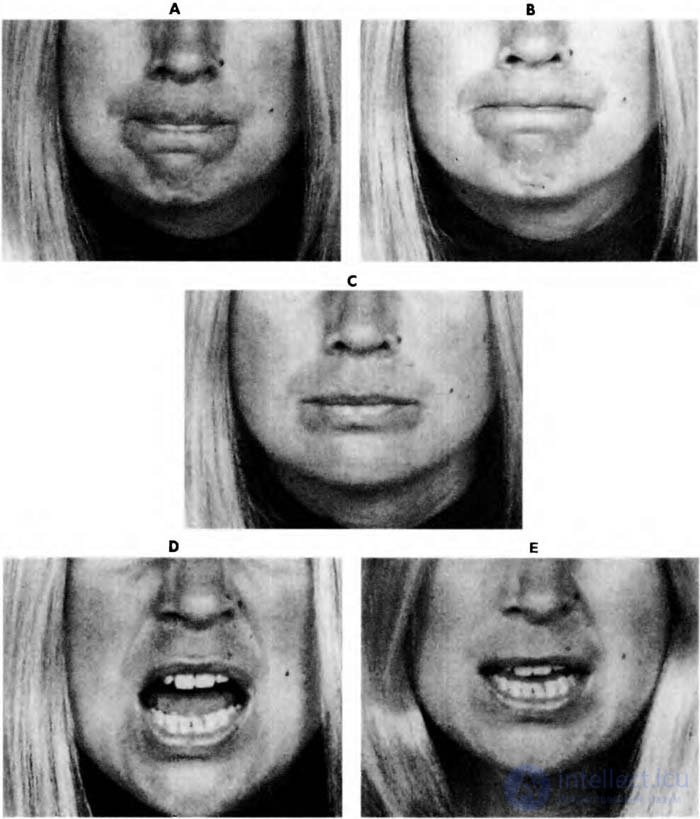
There are two main types of angry mouth. In fig.4 Patricia demonstrates a closed mouth with closed lips (above) and a slightly open mouth of a rectangular shape (below). A mouth with lips tightly closed to each other appears with two completely different types of anger. First, when a person in one form or another performs physical violence, attacking another person. Secondly, when a person tries to control the verbal and sound manifestations of his anger and squeezes his lips, trying to keep himself from shouting out or making words offensive to the offender. In an angry person, his mouth remains open when he is trying to express his anger with words or a cry.
Usually such angry mouths appear on the face with angry eyes and eyebrows, but they can appear on a neutral face. However, the meaning of such a message will be ambiguous, as in the case when anger is expressed only by eyebrows or only by centuries. If anger is expressed only by mouth, then compressed lips can mean a slight anger, controlled anger, physical tension (as when lifting a heavy object) or concentration of attention. A slightly open rectangular mouth also has an ambiguous meaning if the rest of the face’s elements remain neutral, since it may appear with non-anger exclamations (for example, approving cries during a football match) or some verbal sounds.
Figure 5
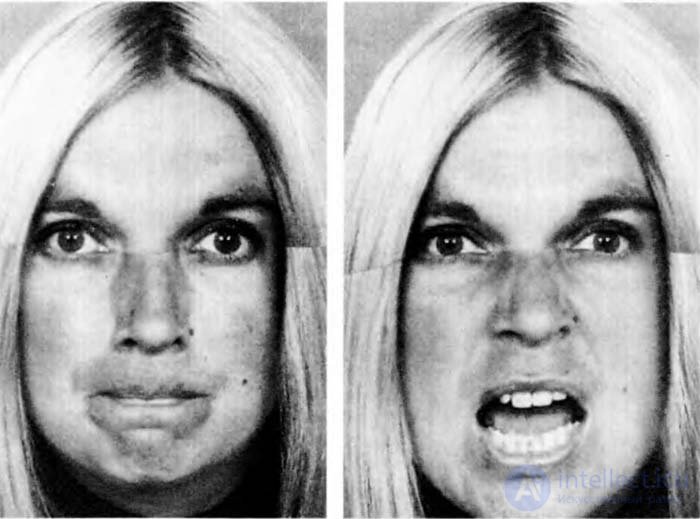
In fig.3 we have shown that if anger is manifested only in two areas of the face, eyebrows and eyelids, then the meaning of the message turns out to be ambiguous. The same is true for the case when anger is expressed only by mouth and eyelids. In fig.Figure 5 shows the composite photographs of Patricia, in which anger is expressed only in the lower part of the face and lower eyelids, and eyebrows and forehead are taken from a neutral face. The meaning of these facial expressions can be any of those discussed above. Signals of a person expressing anger remain ambiguous if anger does not manifest itself in all three areas of the face.The expression of anger on the face is different in this sense from the expressions of emotions that we have already met. Surprise or fear can definitely be expressed by eyebrows - eyes or eyes - mouth. Disgust can be clearly expressed by mouth - by eyes. On the pages dedicated to sadness and joy, you will see that these emotions can also be uniquely expressed with just two areas of the face. And only in the case of anger, if the signals are given only two areas of the face, there is an ambiguity of expression. Ambiguity in expressing anger with two areas of the face can be reduced by using a tone of voice, body position, hand movements or spoken words, as well as by understanding the context in which a particular expression occurs. If you saw the facial expression as in fig. 5 or fig. 3 and Patricia would deny that she was annoyedwhile clenching fists, or if you were shown this expression immediately after you told her the news, which, according to your assumptions, she could not like, then you probably would have rated her anger correctly. Some people may tend to show anger primarily in one or another part of the face when they are able to control this emotion. When this is the case, people who know such a person well — his family members or close friends — can correctly recognize facial expressions similar to those shown in fig. 3 or fig. 5. And although this expression will remain ambiguous for most people, it will be understandable to his close ones.would have rightly appreciated her anger. Some people may tend to show anger primarily in one or another part of the face when they are able to control this emotion. When this is the case, people who know such a person well — his family members or close friends — can correctly recognize facial expressions similar to those shown in fig. 3 or fig. 5. And although this expression will remain ambiguous for most people, it will be understandable to his close ones.would have rightly appreciated her anger. Some people may tend to show anger primarily in one or another part of the face when they are able to control this emotion. When this is the case, people who know such a person well — his family members or close friends — can correctly recognize facial expressions similar to those shown in fig. 3 or fig. 5. And although this expression will remain ambiguous for most people, it will be understandable to his close ones.And although this expression will remain ambiguous for most people, it will be understandable to his close ones.And although this expression will remain ambiguous for most people, it will be understandable to his close ones.
Figure 6
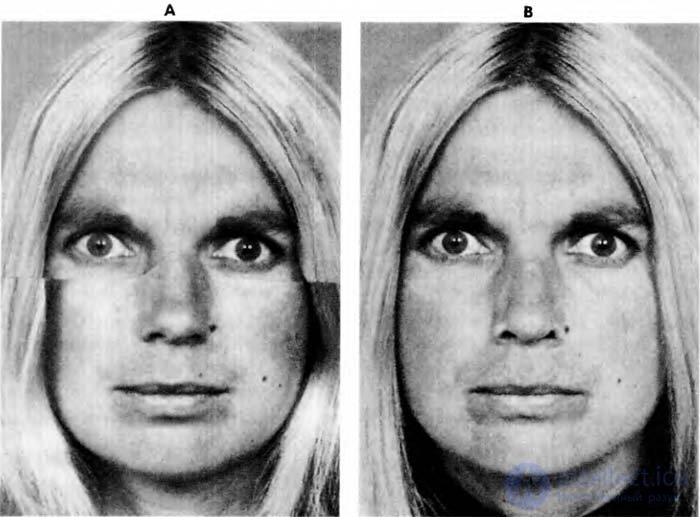
The ambiguity of anger, which manifests itself only in two areas of the face, can be illustrated with another set of photos, where slightly different expressions of anger are shown in the eyelids. In fig.6A, the eyes seem to be rolled out, and the lower eyelids are tense, but not as strong as in fig. 3. If this occurs when the eyebrows are lowered and the mouth is neutral, as shown in fig. 6A, the message will be ambiguous. Patricia can express controlled anger, weak anger, strong intention or determination. If slight tension is added to the lower part of the face, the expression loses its ambiguity. In fig.6B shows the same eyebrows and eyes as in fig. 6A, but on it the upper lip and corners of the mouth are slightly strained, the lower lip is slightly bulged forward, and the nostrils are slightly enlarged. Figure 6B well illustrates that there may not be extremely clear symptoms of anger in all three areas of the face. Brows - forehead on rice. 6B show only a particular symptom of anger. Eyebrows are lowered, but not reduced, and we have just described how weakly the elements of the lower face area are tense. All these particular symptoms that appear on the eyebrows — the forehead and in the lower part of the face, complemented by strained lower eyelids and flared eyes — are enough to identify anger.
Figure 7

In fig.7 Patricia demonstrates two types of angry eyes - a century with two types of angry mouth. Comparing the top pictures with the bottom, we see identical eyes - eyelids and different mouths. Comparing the left and right photos, we see the same mouth, but different eyes.
As we have already explained, this or that type of angry mouth is observed in a person depending on what he does. Anger with a closed mouth, as shown in the upper shots, can occur when a person performs physical violence or if he tries to suppress the desire to scream. The bottom pictures show anger, accompanied by shouts and a stream of words. The wider angry eyes in the right-hand shots make the messages they send a little more expressive.
The intensity of anger can be reflected in the degree of tension of the eyelids or in how strongly the eyes are rolled out in a person. It can also manifest itself in how tightly the lips are closed. In fig.7 lips are compressed strongly enough, we see swelling under the lower lip and wrinkles on the chin. With a weaker anger, the lips do not tighten so much, and the bulge under the lower lip and the wrinkles on the chin become less noticeable or not visible at all. This expression of anger is shown in fig. 6b. An open mouth is also an indicator of the intensity of anger. Less intense anger can also be reflected in only one part of the face or only in two parts, as shown in fig. 3 or fig. 5. But, as we said, it will still be unclear here whether a person experiences mild anger, is angry enough enough, but controls the manifestation of anger on his face, or is not angry at all, but just focused, determined or confused .
The mixed expressions shown in previous chapters were created by merging two emotions, reflected in different areas of the face. Even limited in its manifestation by only one part of the face, each such emotion was also transmitted in a complex message sent to the observer. But if we are talking about anger and the expression of anger does not manifest itself in all three areas of the face, then the transmitted message becomes ambiguous. As a result, when mixed forms of expression of anger, when one or two areas of the face reflect a different emotion, it is usually another emotion that is dominated in the message of anger (another consequence of this is that anger is easily disguised: to reduce the uniqueness of expression, it is enough to control or hide only one area of the face) - We give several examples of mixed emotions,in which the message of the anger being experienced is hardly noticeable. But there are two exceptions, when reports of anger remain clearly visible. First, in the case of a combination of disgust and anger, that part of the message that conveys anger is preserved. This can happen because the combination of disgust and anger occurs quite often, or because there is a similarity of manifestations on the face and a similarity of the situational contexts of these two emotions. Secondly, a mixture of anger and disgust can be created in another way. Creating such a combination does not necessarily require that different areas of the face display different emotions. This can occur when mixing the manifestations of two emotions in each of the areas of the face. Since the creation of such a combination of the message of anger appears in all three areas of the face,then it is in no way obscured or suppressed by another emotion. This combination of emotions is shown in Fig. eight.
Figure 8

Most often, anger is complemented by disgust. In fig.8C Patricia shows anger with disgust, with both emotions mixed in each of the facial areas. It seems that she wants to exclaim: "How dare you show me such a disgusting thing!" In this figure, expressions of anger (8A) and aversion (8B) are also shown for comparison. Look closely at the mouth in the pic. 8C. We see closed lips, as with the manifestation of anger, and a raised upper lip, as with the manifestation of disgust. Patricia’s nose is wrinkled, indicating a disgust. The lower eyelids are slightly tense, as when expressing anger, but the bags and folds under the eyelids, characteristic of the expression of disgust, are created by wrinkling the nose and lifting the cheeks. Upper eyelids are lowered and tense - this change occurs either with anger or with disgust.But lowered eyebrows occupy an intermediate position between the expression of anger and the expression of fear - they are reduced only partially.
Figure 9
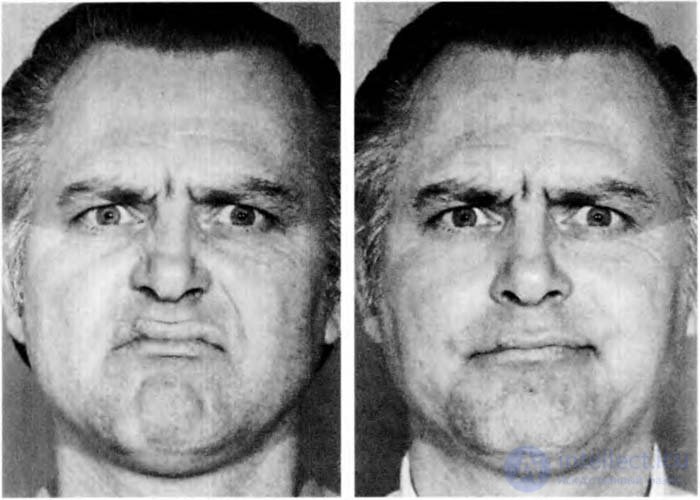
In fig.9 John shows two other mixed expressions of anger and disgust. They manifest themselves in pure form in different areas of the face, and not at the expense of manifestation in each of the areas. In fig. 9A anger express eyebrows and eyes, and the mouth - disgust. In fig. 9B John shows a combination of contempt and disgust: mouth expresses disgust, and anger expresses his eyes and eyebrows.
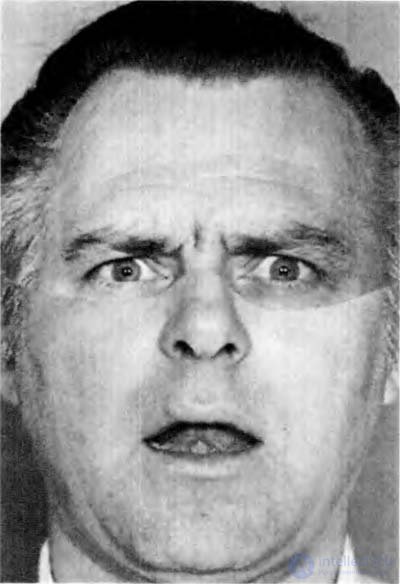
Figure 10
At the same moment you can be surprised and angry. Suppose that John was already surprised by something, and then some other unexpected event happened that provoked anger. In fig.10 John demonstrates anger and surprise, while mouth expresses surprise, and anger expresses eyebrows and eyes. Note, however, that the element of surprise occupies a dominant position in the message. We are not convinced that John is angry. This facial expression could also arise in the case of puzzled astonishment (remember that lowered and flattened eyebrows may express bewilderment as well).
Figure 11

Fear and anger can be caused by various provocative events and threats, and these emotions sometimes mix for a while, while the person tries to cope with the situation. In fig. 11 we see two such expressions of anger and fear. In fig. 11B and fig. 11C fear expresses a mouth, and anger - eyebrows and eyes. Again, note that anger does not play a dominant role in general facial expressions and manifests itself much weaker than fear. In fact, these two facial expressions (11B and 11C) could arise in the complete absence of anger and be caused by fear and bewilderment, or only by fear, on which a person concentrates all his attention. Patricia's face in pic. 11A is shown because it demonstrates a combination of elements of fear and anger (frightened eyebrows and eyes, an angry mouth), but this is one of those individuals who have doubts about whether they really express a mixture of these two emotions. It is more likely that such a combination would have arisen if Patricia was frightened and tried to hold back a cry, tightly clutching her lips, to try to control her fear.
Anger can also be mixed with joy and sadness.
Anger is manifested in each of the three areas of the face (Fig. 12).
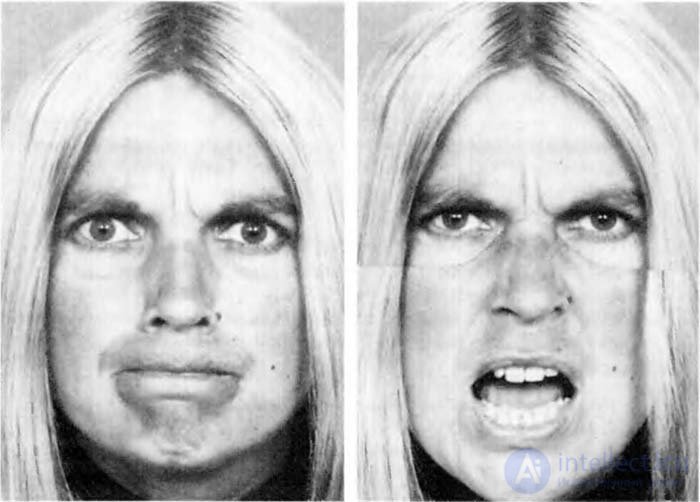
Figure 12
With the help of these exercises, you will learn to give ambiguous expressions to angry people.
Read again the instructions for doing this task on the page of fear. Now you can add faces that express disgust and anger and combinations of anger, disgust, fear and surprise. First, practice the following expressions of anger, disgust, and combinations of these two emotions. When you learn to distinguish them without mistakes, add to them expressions of fear and surprise. Practice until you give 100% correct answers.
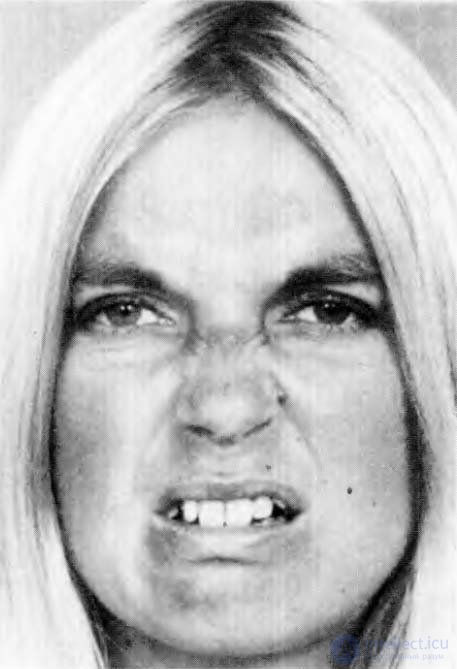 |
Disgust all over face |
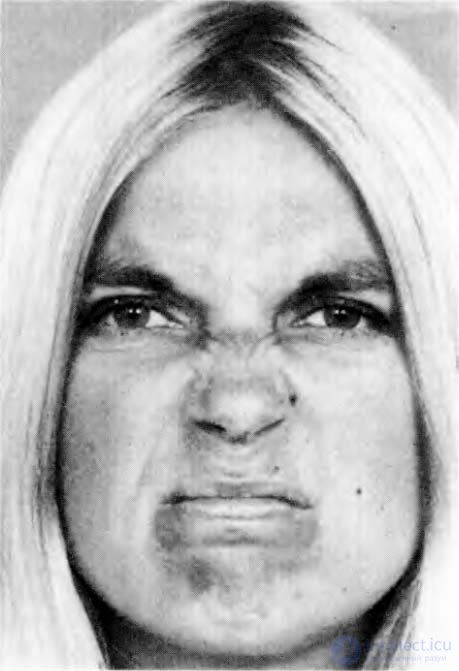 |
Disgust all over face |
 |
Contempt |
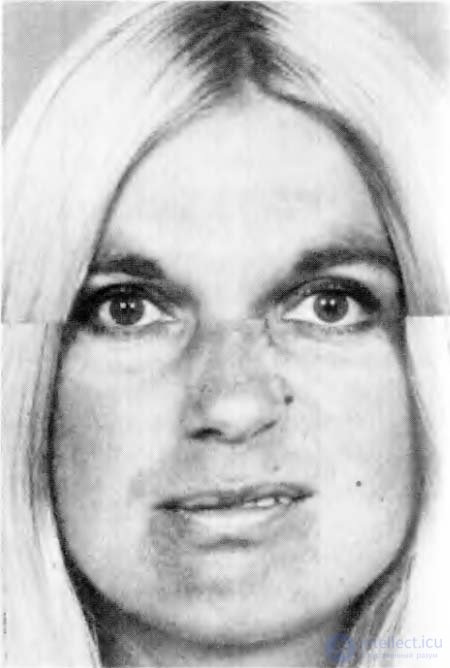 |
Contempt |
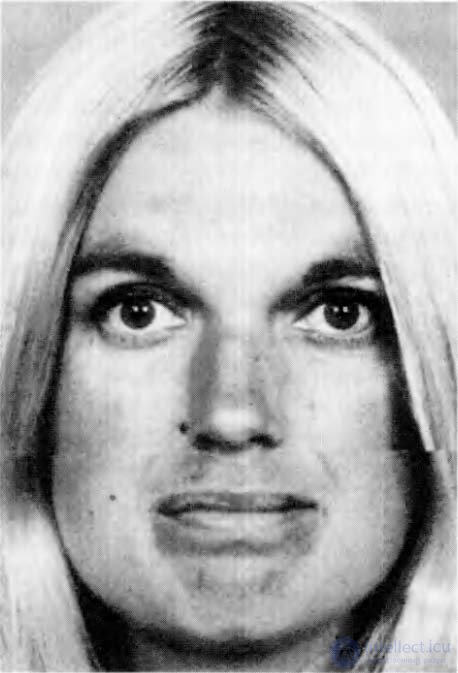 |
Contempt |
 |
The combination of surprise and disgust or stressed disgust |
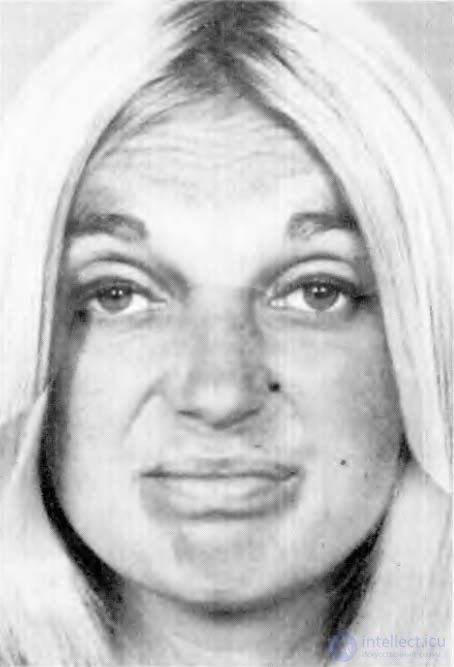 |
Disbelief |
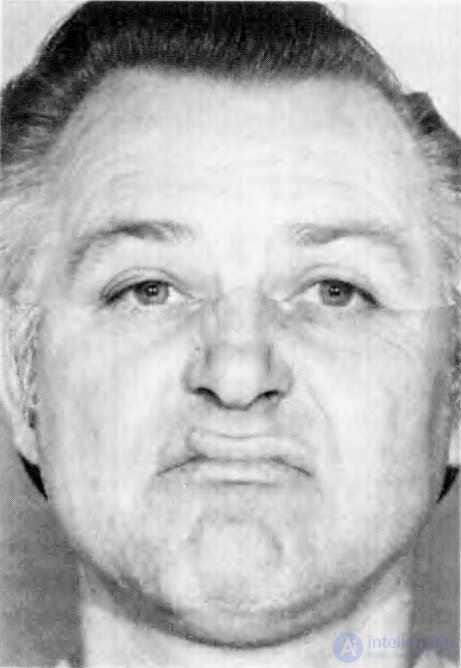 |
Disbelief |
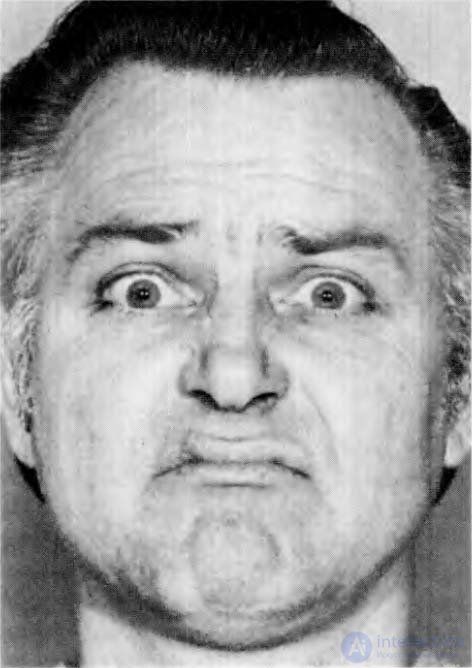 |
The combination of fear and disgust |
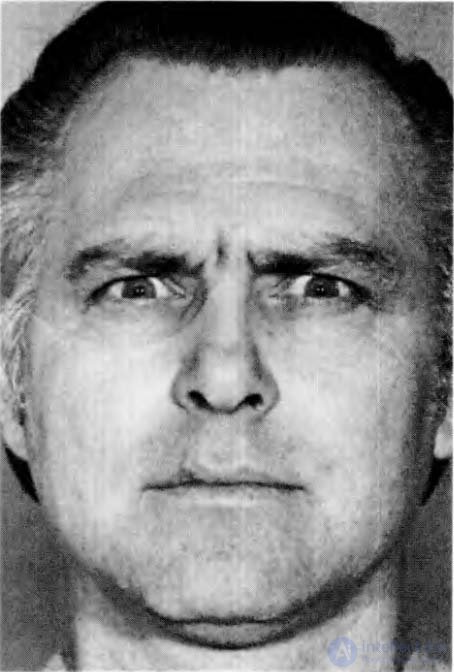 |
Controlled, mild anger or bewilderment |
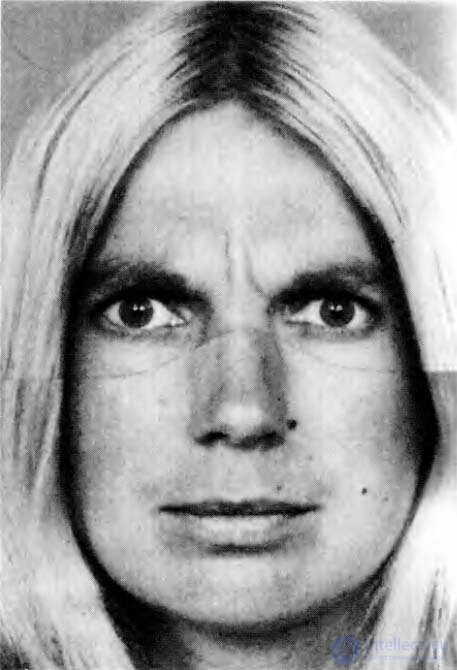 |
Easy anger, controlled anger, concentration, etc. |
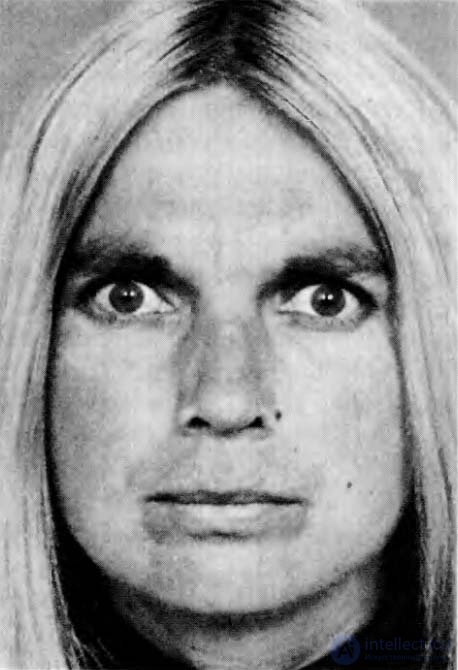 |
Controlled, or easy, anger |
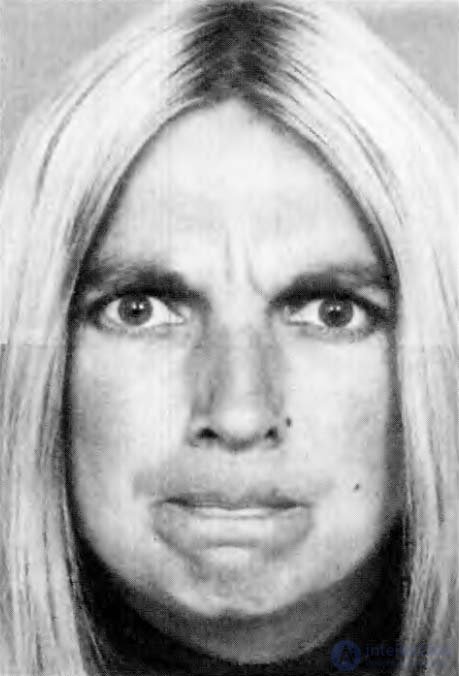 |
Expression of anger all over his face |
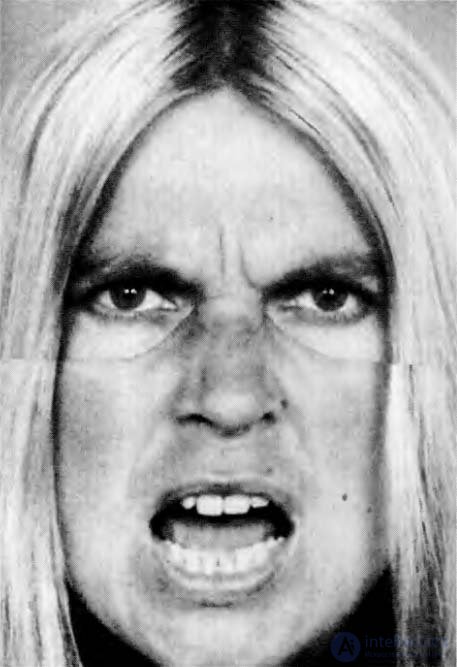 |
Expression of anger all over his face |
 |
The combination of anger and disgust |
 |
The combination of anger and disgust |
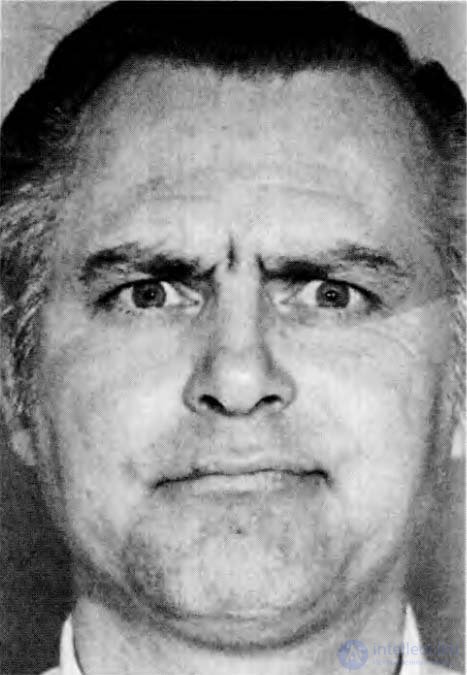 |
The combination of anger and contempt |
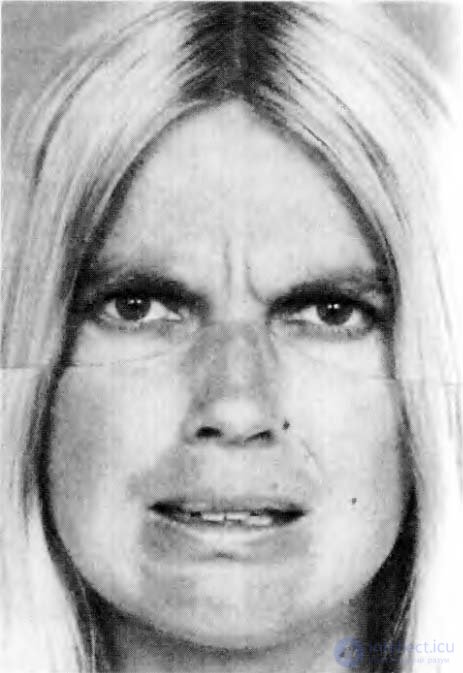 |
Combination of fear and anger or puzzled fear |
Comments
To leave a comment
Psychology of emotions
Terms: Psychology of emotions